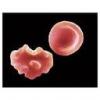Reputation Activity
-
 The risk explained to me in HLA-matched platelets is that the donor would be homozygous for an HLA antigen shared with the recipient. The T-cells in the unit would survive and could engraft because the recipient does not see them as foreign. However, the recipient may be heterozygous for that shared antigen and so have an HLA antigen that the donor lacks. Because the recipient can't destroy the T-cells with the homozygous expression but the donor's engrafted T-cells can make HLA antibodies directed at the recipient and cause GVHD the platelets must be irradiated so the donor's T-cells don't survive to engraft. This is also why countries with more closely related populations may require that all blood products be irradiated because even a RBC unit could carry one of these stealthy homozygous T-cells.
The risk explained to me in HLA-matched platelets is that the donor would be homozygous for an HLA antigen shared with the recipient. The T-cells in the unit would survive and could engraft because the recipient does not see them as foreign. However, the recipient may be heterozygous for that shared antigen and so have an HLA antigen that the donor lacks. Because the recipient can't destroy the T-cells with the homozygous expression but the donor's engrafted T-cells can make HLA antibodies directed at the recipient and cause GVHD the platelets must be irradiated so the donor's T-cells don't survive to engraft. This is also why countries with more closely related populations may require that all blood products be irradiated because even a RBC unit could carry one of these stealthy homozygous T-cells.
-
 Malcolm Needs reacted to Mabel Adams in How could this patient develop anti-E?We do the same but it is partly because we are remote from our blood center and surrounded by smaller hospitals that don't do Ab IDs. We think it is worth preserving the ability to give Rh neg blood in an emergency to a patient with anti-E, whereas if they also have anti-c already reacting strong enough to detect, there are fewer and poorer options. Others will argue that it is not appropriate to use the limited c neg units on patients lacking the antibody.
Malcolm Needs reacted to Mabel Adams in How could this patient develop anti-E?We do the same but it is partly because we are remote from our blood center and surrounded by smaller hospitals that don't do Ab IDs. We think it is worth preserving the ability to give Rh neg blood in an emergency to a patient with anti-E, whereas if they also have anti-c already reacting strong enough to detect, there are fewer and poorer options. Others will argue that it is not appropriate to use the limited c neg units on patients lacking the antibody.
-
 Malcolm Needs got a reaction from John C. Staley in How much experience do you have in the field and how long did it take you to feel comfortable?Good luck in your new poeition John. From what I have learned from your posts on here, and from the people with whom you have worked in the past, who have posted about you, I am certain that you will be a great success.
Malcolm Needs got a reaction from John C. Staley in How much experience do you have in the field and how long did it take you to feel comfortable?Good luck in your new poeition John. From what I have learned from your posts on here, and from the people with whom you have worked in the past, who have posted about you, I am certain that you will be a great success.
-
 Malcolm Needs got a reaction from Cliff in How much experience do you have in the field and how long did it take you to feel comfortable?Good luck in your new poeition John. From what I have learned from your posts on here, and from the people with whom you have worked in the past, who have posted about you, I am certain that you will be a great success.
Malcolm Needs got a reaction from Cliff in How much experience do you have in the field and how long did it take you to feel comfortable?Good luck in your new poeition John. From what I have learned from your posts on here, and from the people with whom you have worked in the past, who have posted about you, I am certain that you will be a great success.
-
 Malcolm Needs reacted to bb4me in How much experience do you have in the field and how long did it take you to feel comfortable?On and off, about 15 years. It took me a couple of years to become more "comfortable" in all areas of the lab, in that I felt that my judgement improved to the point where I felt more confident that I probably wouldn't harm a patient from either overconfidence or "analysis paralysis".
Malcolm Needs reacted to bb4me in How much experience do you have in the field and how long did it take you to feel comfortable?On and off, about 15 years. It took me a couple of years to become more "comfortable" in all areas of the lab, in that I felt that my judgement improved to the point where I felt more confident that I probably wouldn't harm a patient from either overconfidence or "analysis paralysis".
At times, Blood Banking may seem a little more dramatic thank some other areas of the lab, but one of the key points I try to make with students/trainees is this: Blood Banking calls on the same skill sets that you use in the rest of the lab. If you can multitask, keep cool under pressure, understand your limits, and recongize that little bell that rings in your head that says "Wasn't there something odd about (insert situation here) that I learned in school/read about in a journal/saw on a similar case once?", you'll do fine in Blood Bank, and welcome!
(Of course, it helps to love Blood Banking too!)
-
 Malcolm Needs got a reaction from Dr. Pepper in What is your procedure for resolving the following typing discrepancy?Any news about a BMT?
Malcolm Needs got a reaction from Dr. Pepper in What is your procedure for resolving the following typing discrepancy?Any news about a BMT?
I remember one case where a very goof friend of mine had a bit of a shock when a baby's group excluded the mother. He thought about a baby swap and all sorts of other things, and almost decided that he could no longer do ABO grouping (he was/is a VERY senior member of the blood transfusion fraternity in the UK).
It turned out that that the mother had received a BMT earlier in her life, and the baby was the result of an ovum gifted from her sister.
-
 Malcolm Needs got a reaction from tbostock in What is your procedure for resolving the following typing discrepancy?Then they should! Simple as that.
Malcolm Needs got a reaction from tbostock in What is your procedure for resolving the following typing discrepancy?Then they should! Simple as that.
Grumpy of England.
-
 Malcolm Needs reacted to David Saikin in What is your procedure for resolving the following typing discrepancy?After confirming the previous result of weak rx with anti-A I would try to absorb and elute anti-A off her red cells (you never have a student when you need one!). You could also put your front type at 4C for 10 minutes to see what happens (use pt cells in Rh ct as a control).
Malcolm Needs reacted to David Saikin in What is your procedure for resolving the following typing discrepancy?After confirming the previous result of weak rx with anti-A I would try to absorb and elute anti-A off her red cells (you never have a student when you need one!). You could also put your front type at 4C for 10 minutes to see what happens (use pt cells in Rh ct as a control).
-
 Jesus did work for our lab for a while but then he got accepted into medical school.
Jesus did work for our lab for a while but then he got accepted into medical school.
-
 Anybody who works anywhere in the Lab has to have competencies and other stuff documented at least yearly anyway. If Jesus Christ walked into our Lab He wouldn't be allowed to do any testing until he was appropriately checked off for each type of test that is performed.
Anybody who works anywhere in the Lab has to have competencies and other stuff documented at least yearly anyway. If Jesus Christ walked into our Lab He wouldn't be allowed to do any testing until he was appropriately checked off for each type of test that is performed.
Besides the obvious risk to patient safety, during a tracer inspection if the inspector happens to check work that that director did and there are no current competencies on record, you would certianly get cited.
Scott
-
 Malcolm Needs got a reaction from David Saikin in Warm Auto Workup FrequencyI sort of agree with you there Mabel. You certainly will not detect anything in the panel that you would not detect using screening cells. However, so many times we see reactions against, for example, the R1R1 and rr screening cells, against the plasma adsorbed with R2R2 cells, which means that we then have to go on to prove that the reaction is due to an auto-anti-e (or, more likely, an auto-anti-e-like antibody) that has not been adsorbed out by the R2R2 cells, meaning that we have to perform a panel to prove this, that we just throw our hands up in submission and perform panels anyway. We are "savvy enough", however, to perform the panels with selected cells, rather than the full panel.
Malcolm Needs got a reaction from David Saikin in Warm Auto Workup FrequencyI sort of agree with you there Mabel. You certainly will not detect anything in the panel that you would not detect using screening cells. However, so many times we see reactions against, for example, the R1R1 and rr screening cells, against the plasma adsorbed with R2R2 cells, which means that we then have to go on to prove that the reaction is due to an auto-anti-e (or, more likely, an auto-anti-e-like antibody) that has not been adsorbed out by the R2R2 cells, meaning that we have to perform a panel to prove this, that we just throw our hands up in submission and perform panels anyway. We are "savvy enough", however, to perform the panels with selected cells, rather than the full panel.
I totally agree with your final point.
-
 Malcolm Needs got a reaction from David Saikin in Warm Auto Workup FrequencyNot in the UK. We may cross-match by "immediate spin", but only after we have performed the alloadsorption and "proved" that there are no underlying alloantibodies.
Malcolm Needs got a reaction from David Saikin in Warm Auto Workup FrequencyNot in the UK. We may cross-match by "immediate spin", but only after we have performed the alloadsorption and "proved" that there are no underlying alloantibodies.
I put "proved" in quotation marks as, of course, the alloadsorption cells will remove any antibody directed against a high prevalence antigen (such as Vel) that is not sensitive to papain (we always use papain-treated red cells for the alloadsorption, as they adsorb more effectively than do untreated red cells. The units are always issued as 2suitable", rather than "compatible" for this reason, with a warning that observation during transfusion is "even more" paramount (if that isn't an oxymoron, I don't know what is!!) than normal.
Actually, come to think of it, there will be rare occasions when we cannot fully adsorb out the auto-antibody, in which case we would recommend giving ABO, Rh and K matched blood and, if the auto-antibody is a "cold" auto-antibody of wide thermal amplitude, even an "immediate spin" cross-match may not be compatible, but this is indeed a rare situation.
-
 We are doing titers on a prenatal patient with anti-c and anti-Fyb. Lots of fun!
We are doing titers on a prenatal patient with anti-c and anti-Fyb. Lots of fun!
-
 We train for at least 3 weeks in BB, sometimes 4. I would think someone out of it for 30 years would need to be completely trained. We had someone out on FMLA for 6 months and we had to bring them in for retraining. So 30 years...wow...yes.
We train for at least 3 weeks in BB, sometimes 4. I would think someone out of it for 30 years would need to be completely trained. We had someone out on FMLA for 6 months and we had to bring them in for retraining. So 30 years...wow...yes.
-
 Twenty-eight dittos to all of the above (if dittos are in policy and I have been trained in the use thereof and found to be competent). Needs to go through the exact same training/competency/signoff.
Twenty-eight dittos to all of the above (if dittos are in policy and I have been trained in the use thereof and found to be competent). Needs to go through the exact same training/competency/signoff.
The only possible variable in our training is time: obviously, a seasoned vet will need less training time than a new graduate.
-
 Two words: patient safety.
Two words: patient safety.
Having anyone working a bench who has not been through the usual training and staff competencies is a risk to patient safety. Just because you are a manager does not mean you are a competent worker bee.
Would Nursing, Pharmacy, Radiology let a department director work in their depts w/o adequate training.
Best of luck to you with this dilemma . When I was a manager I did competencies just like everyone else on staff. And as a PRN I am still expected to do my yearly mandatory training.
-
 You should have no trouble at all phenotyping the baby if you use monoclonal IgM reagents. You should also have, as a matter of course, the mother's phenotype. These two pieces of information are not an optional extra. AND you should see what you're getting out of the eluate.
You should have no trouble at all phenotyping the baby if you use monoclonal IgM reagents. You should also have, as a matter of course, the mother's phenotype. These two pieces of information are not an optional extra. AND you should see what you're getting out of the eluate.
-
 Malcolm Needs reacted to Bayou in SBB ExamThanks Malcolm. It's a huge relief!
Malcolm Needs reacted to Bayou in SBB ExamThanks Malcolm. It's a huge relief!
-
 Malcolm Needs reacted to Bayou in SBB ExamI just passed the test yesterday! I am hugely relieved. I studied the Gulf Coast last chance review, the AABB notes on sbb and the physicians handbook. All are great sources and would recommend to learn them all!
Malcolm Needs reacted to Bayou in SBB ExamI just passed the test yesterday! I am hugely relieved. I studied the Gulf Coast last chance review, the AABB notes on sbb and the physicians handbook. All are great sources and would recommend to learn them all!
-
 Malcolm Needs reacted to galvania in How much experience do you have in the field and how long did it take you to feel comfortable?I still see new things now.......even after all this time!
Malcolm Needs reacted to galvania in How much experience do you have in the field and how long did it take you to feel comfortable?I still see new things now.......even after all this time!
-
 Malcolm Needs reacted to David Saikin in Expiration DateDitto with Anna
Malcolm Needs reacted to David Saikin in Expiration DateDitto with Anna
-
 Malcolm Needs reacted to galvania in Expiration DateFor me a no brainer - September 30th or 6 months, whichever is the earliest. Not a question of CAP or anything else, just common sense
Malcolm Needs reacted to galvania in Expiration DateFor me a no brainer - September 30th or 6 months, whichever is the earliest. Not a question of CAP or anything else, just common sense
So, you make up the solution on January 1st - you can use it till July 1st
You make up the solution on May 1st - you can use it till September 30th
You make up the solution on July 1st - you can use it till September 30th
Unless (which I doubt) it specifically says otherwise in the accompanying box insert (IFU)
-
 Malcolm Needs reacted to SMILLER in use of arrows on formsditto on getting the point on all this...
Malcolm Needs reacted to SMILLER in use of arrows on formsditto on getting the point on all this...
Scott (aka " )
-
 Malcolm Needs reacted to pstruik in use of arrows on formsThere is a certain delicious irony in a - very sensible - question about the non-use of arrows asking people to point you in the right direction ...
Malcolm Needs reacted to pstruik in use of arrows on formsThere is a certain delicious irony in a - very sensible - question about the non-use of arrows asking people to point you in the right direction ...
-
 You could always try an elution . . . I have seen neg DATs with a strongly positive eluate in gel. (using the Immucor ELU II kit).
You could always try an elution . . . I have seen neg DATs with a strongly positive eluate in gel. (using the Immucor ELU II kit).





